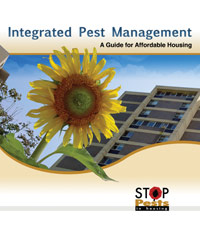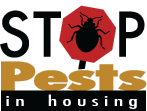Integrated Pest Management: A Guide for Affordable Housing
Affordable multifamily housing presents unique challenges for those trying to manage bed bugs, cockroaches, and rodents. Pest-free housing is a realistic goal, but a network of staff, pest management professionals, and residents must cooperate to successfully manage pests building-wide.
 |
Integrated Pest Management: A Guide for Affordable Housing is a resource that will help affordable housing managers, owners, and agents use integrated pest management (IPM) to contend with a variety of urban pests in their facilities. It will also serve as a useful tool for anyone seeking to integrate IPM practices into a residential pest management strategy.
The illustrated, 81-page guide gives readers
- a basic knowledge of pests and pesticides that will help them make informed pest control decisions with a pest management professional;
- an understanding of how to implement IPM in housing; and
- tools to orient staff to their role on an IPM team.
 Integrated Pest Management: A Guide for Affordable Housing (entire publication in English, PDF, 25 MB)
Integrated Pest Management: A Guide for Affordable Housing (entire publication in English, PDF, 25 MB)
 Manejo Integrado de Plagas: Una Guía para la Vivienda Accesible (páginas 1–42 en español, PDF, 23 MB)
Manejo Integrado de Plagas: Una Guía para la Vivienda Accesible (páginas 1–42 en español, PDF, 23 MB)
Download the appendices separately
- Appendix A. U.S. Department of Housing and Urban Development Office of Public and Indian Housing Promotion of Integrated Pest Management (IPM) as an environmentally-sound, economical and effective means to address a major resident concern (Notice: PIH-2011-22) (PDF)
- Appendix B. U.S. Department of Housing and Urban Development Office of Public and Indian Housing Guidelines on Bedbug Control and Prevention in Public Housing (Notice: PIH 2012-17) (PDF)
- Appendix C. U.S. Department of Housing and Urban Development Guidelines on Addressing Infestations in HUD-insured and Assisted Multifamily Housing (Notice: H 2012-5) (PDF)
- Appendix D. IPM Focus Unit Tracking Log (DOCX)
- Appendix E. Sample Request for Proposal (RFP) and Scope of Work for Pest Control (including site-specific IPM plan guidelines) (DOCX)
- Appendix F. Suggested Housekeeping and Lease Language
- Appendix G. Employee Certificate of Completion (PDF)
Integrated Pest Management: A Guide for Affordable Housing was developed by the Northeastern IPM Center as part of “Delivery of IPM Training to Public Housing Authorities,” a project supported through an interagency agreement between the U.S. Department of Agriculture’s National Institute of Food and Agriculture (USDA-NIFA) and the U.S. Department of Housing and Urban Development (HUD) Office of Healthy Homes and Lead Hazard Control. The guide is based on a training curriculum that was reviewed and supported by the National Pest Management Association (NPMA), Pennsylvania IPM Program, U.S. Centers for Disease Control and Prevention (CDC), HUD, USDA-NIFA, and U.S. Environmental Protection Agency (EPA).

